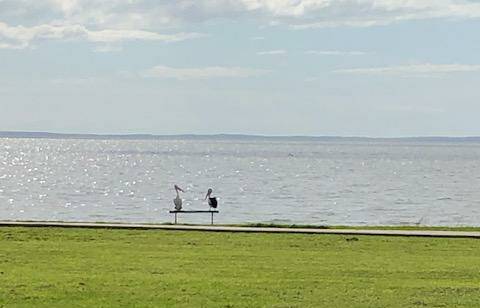
Coorong fishers say there have been improvements to the iconic wetland, with this being attributed to the policy of delivering water for environmental causes through the Murray-Darling Basin Plan.
Coorong fishers are reporting signs of the slow recovery to parts of the iconic wetland, thanks largely to the delivery of water for the environment.
Despite dry conditions across the MDB in the past four years, water for the environment has been delivered in small volumes via the barrages and fishways, helping to keep parts of the Coorong functioning.
The much-needed fresh water is helping to lower salinity in the north lagoon of the Coorong, and two local fishermen say this is benefitting native fish populations.
Glen Hill, Coorong Wild Seafood, Meningie, said bigger fish such as flounder and black bream, which are estuary dependent, are building in numbers - proof the environmental water releases are working.
"I often like to find out what the fish are eating and can attribute healthy looking fish to the food available," he said.
"This is due to the response of the bottom end of the food chain to the environmental flows released into the Coorong.
"It's positive to see, however it's only half the story as there are not enough environmental flows to see the same response in the South Lagoon."
Garry Hera-Singh,Meningie, has been a commercial fisher for 38 years and has observed increased abundance and diversity of the many fish species in the Coorong across the past decade.
"Increased productivity has been purely driven by strategic and managed annual releases of environmental water through the barrage network," he said.
"While this is a fantastic outcome, more water for the environment is needed to be delivered to the Coorong to build a higher level of resilience within the aquatic ecology for the next drought, and to buffer the impacts of long term climate change facing the region.
"Specifically, more river flow is needed to address the degradation of habitat issues plaguing the South Lagoon of the Coorong.
"Once upon a time (pre-white man) this region was a major fish habitat and nursery area."
Coorong, Lower Lakes and Murray Mouth program leader Adrienne Rumbelow said during summer and autumn, salinity in the South Lagoon often exceeded 100 parts per thousand (three times the salinity of seawater) and was largely uninhabitable for most native fish.
RELATED:
"This is not a natural condition in the South Lagoon," she said.
"High flows from the River Murray are needed to dilute and flush this salt from the system, yet this critical process has been happening much less frequently in recent decades.
"River regulation and development have resulted in significant disruption to natural flows to the Coorong.
"Many of our rivers and wetlands have been modified as the population has grown to provide water for towns, industry and food production.
"In some rivers, up to half of the water that would have naturally flowed in them is removed each year for critical human water needs, irrigation and industry.
"This means that end of system flows to the Coorong are now just a small fraction of what would have occurred naturally."
Ms Rumbelow said water for the environment was water allocated and managed to improve the health of rivers, wetlands and floodplains across the MDB.
"Water for the environment allows us to actively manage how some water flows through these waterways and reintroduce a more natural flow regime - these flows are what we call 'water for the environment'," she said.
"Much of this water has been provided through the return flows of water delivered by the Commonwealth Environmental Water Holder to achieve environmental benefits in river channels and floodplains in NSW, Vic and elsewhere in SA.
"The return flows from these environmental waterings have made their way down to the Lower Lakes and allowed at least some fresh water to flow from the River Murray to the Coorong at all times.
"As a result of the provision of environmental water, there has been almost 11 years of continuous connectivity between the freshwater river environment and the sea.
"Without water for the environment, there would have been no freshwater flow to the Coorong between January 2018 to August 2020 and the ecology of the Coorong would have collapsed.
"These improvements have been most evident since Basin Plan implementation began in 2012 and it's rewarding to know the changes have been noticed and appreciated by the Coorong's commercial fishing industry."
Project Coorong's Healthy Coorong, Healthy Basin initiative is also investigating possible long-term management measures to improve the health of the Coorong South Lagoon to include, among other things, thriving fish communities.
Start the day with all the big news in agriculture. Sign up here to receive our daily Stock Journal newsletter.

